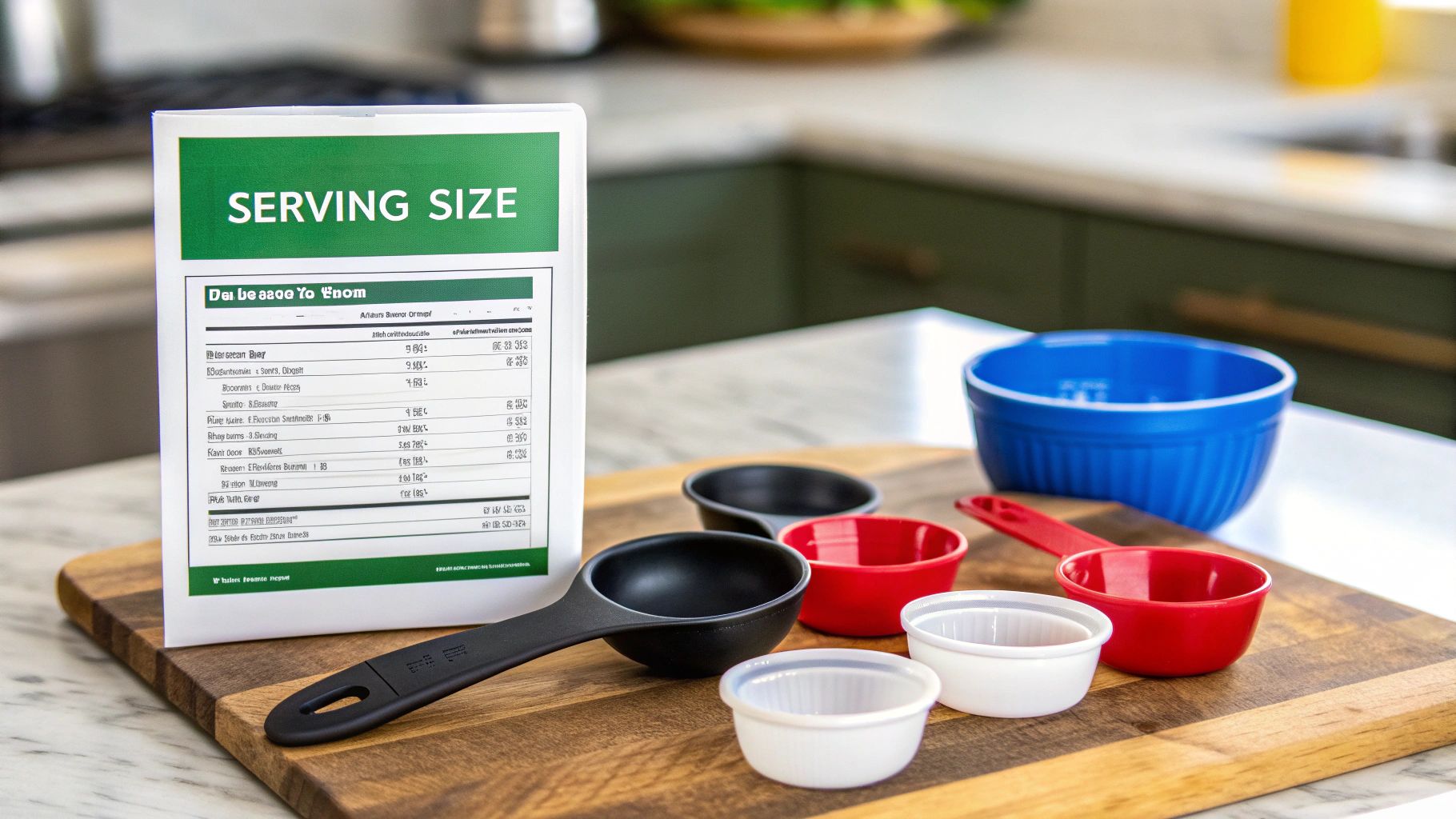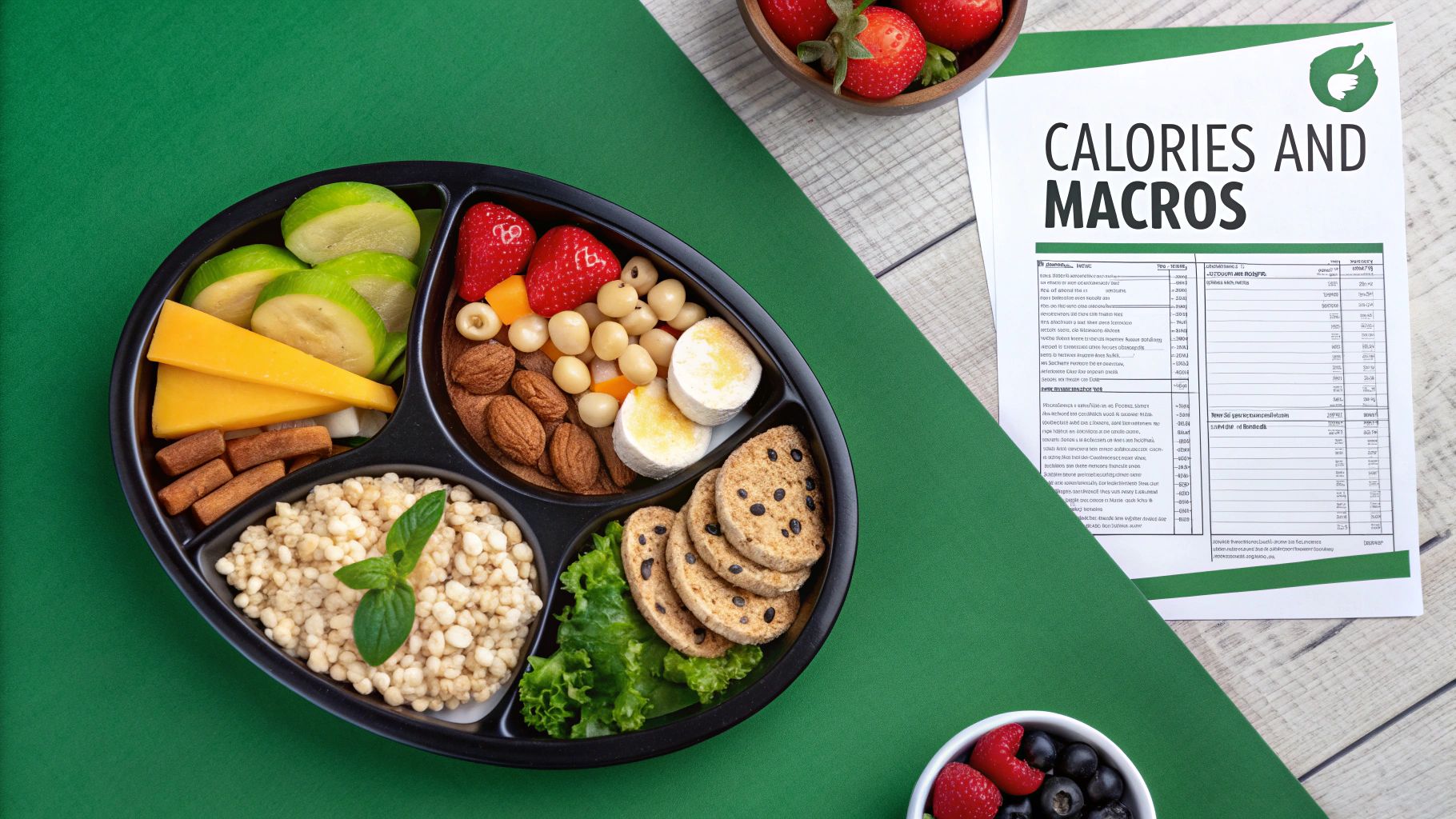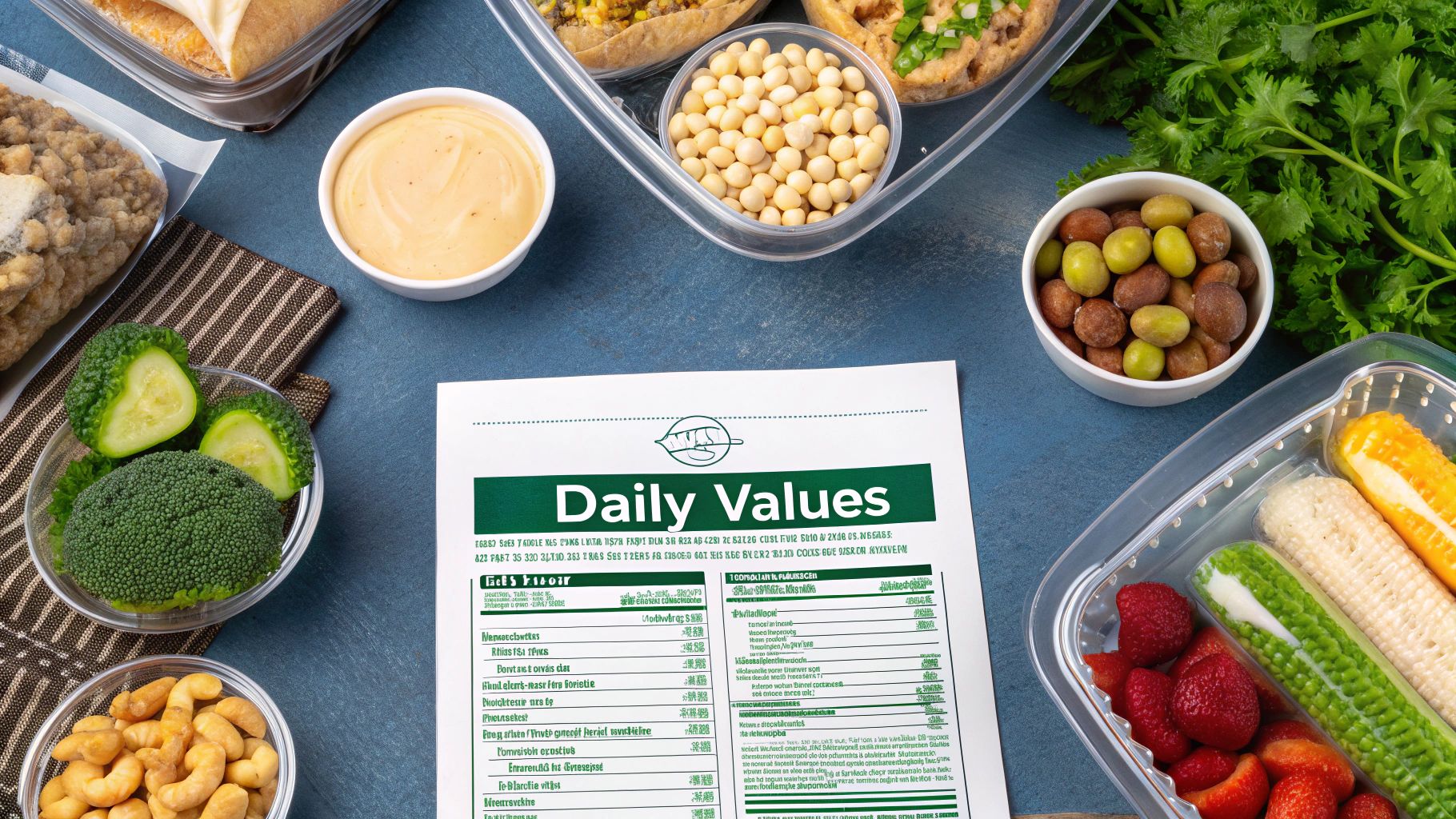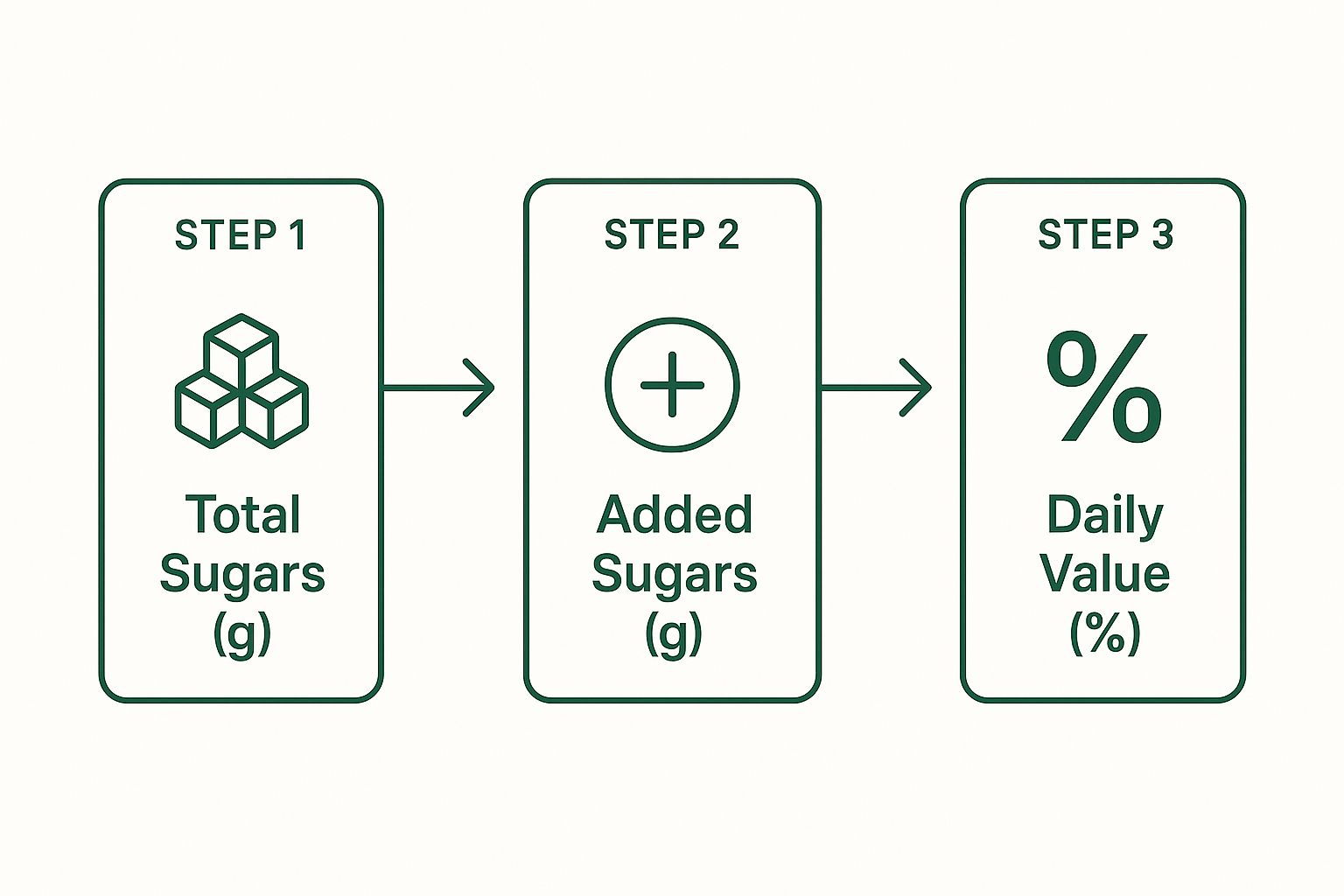How to Read Nutrition Labels Like a Pro
Tired of confusing food labels? Learn how to read nutrition labels with this simple guide to serving sizes, calories, macros, and making smarter food choices.
Love This Article?
Get personalized meal plans with recipes like this, automatically matched to your nutrition targets.

How to Read Nutrition Labels Like a Pro
Ever felt like you need a secret decoder ring just to figure out what's in your food? That block of text and numbers on the back of the package can be intimidating, but I promise it's not as complicated as it looks. Once you get the hang of it, you'll be able to size up any food in seconds.
The trick is to know where to look and in what order. I always tell my clients to focus on four key things: Serving Size, Calories, Macronutrients, and the Percent Daily Value (%DV). Nail these four, and you'll go from confused to confident in the grocery aisle.
Cracking the Code of a Nutrition Label

Alright, let's break this down. Think of the nutrition label as a food's résumé. Your job is to quickly vet it to see if it’s a good fit for your goals.
The absolute first place your eyes should go is the Serving Size. This is the non-negotiable starting point because every single other number on that label—from calories to carbs—is based only on that specific amount. It's a classic mistake to think the whole bag of chips is 150 calories when that's just for one small handful!
With the serving size in mind, your next glance should be at the big, bold number: Calories. This is your quick-and-dirty assessment of the food's energy payload. It's a critical piece of the puzzle, whether you're trying to manage your weight or just fuel up for a workout.
Looking Beyond the Calorie Count
But here's where the real detective work begins, because calories don't tell the whole story. You need to know where those calories are coming from. That's when you scan the macronutrients: the breakdown of fat, carbohydrates, and protein. Is this a food packed with fiber-rich carbs and lean protein, or is it mostly sugar and saturated fat? This is how you judge the quality of the food.
Finally, you put it all into context with the Percent Daily Value (%DV). This column tells you if the serving has a little or a lot of a certain nutrient, all based on a general 2,000-calorie diet. It helps you make smart trade-offs. For example, you might see a yogurt is high in added sugar but also a fantastic source of calcium. The %DV helps you decide if that trade-off is worth it for you.
Key Takeaway: Never judge a food by a single number. A snack might be low-calorie but a total salt bomb, or it could seem high in fat, but it’s the good, heart-healthy kind. The real skill is seeing how all the pieces of the label fit together.
To make this even easier, here's a little cheat sheet I use to quickly make sense of it all.
Your Nutrition Label Cheat Sheet
This table breaks down the four most critical parts of the label and the key question each one answers.
| Label Section | What It Really Means | The Bottom Line |
| Serving Size | The amount all other numbers are based on. | "How much am I *actually* eating?" |
| Calories | The total energy in one serving. | "Will this fit my daily energy budget?" |
| Macronutrients | The source of the calories (fats, carbs, protein). | "What kind of fuel am I getting?" |
| Percent Daily Value (%DV) | How much a nutrient contributes to a daily diet. | "Is this high or low in the stuff I care about?" |
Keep these four questions in mind, and you'll be able to interpret any label like a pro.
Interestingly, while most of us know we should check labels, putting that knowledge into practice can be tough. International studies have shown that even when people look at labels, they often struggle to calculate nutrient totals based on their actual portion size. That's why recent FDA updates made things like calories, serving size, and added sugars bigger and bolder—they're the things most of us look for anyway
The Serving Size and Calorie Count Reality Check
Alright, let's start at the top of the label. This is ground zero for understanding what you're about to eat, and honestly, it's where most people get tripped up. The first two numbers you’ll see—serving size and calories—are the foundation for everything that follows, and they can be seriously deceiving.
It all begins with the serving size. Think of this less as a "recommendation" and more as a "reference amount." It’s the portion all the other numbers on the label are based on. Ever crushed what you thought was a single-serving bag of chips, only to glance at the back and see "Servings Per Container: 3.5"? Yeah, we've all been there. That seemingly harmless 100-calorie snack just turned into a 350-calorie decision. Whoops.
This is where a little bit of what I call "aisle math" comes in handy. To figure out what you're really putting in your body, you have to multiply the calories (and fats, and carbs, etc.) by the number of servings you actually plan on eating.
My Two-Cents: Before you even put it in your cart, check the "Servings Per Container." If it’s more than one, be honest with yourself. Are you really only going to eat eight crackers? If not, do the multiplication right then and there to avoid a surprise later.
Going Beyond Just the Numbers
Now, let's talk about calories. The big, bold number is impossible to miss, but the story doesn't end there. Where those calories come from is just as crucial, if not more so. This is where we get into the idea of calorie density.
Let's be real: 200 calories of gummy bears and 200 calories of avocado are going to have wildly different effects on your body and your hunger levels.

As you can see on this classic label, the calories and serving size are right at the top. They're your first checkpoint when you pick up any packaged food.
The gummy bears will give you a quick spike of energy followed by a crash, leaving you hunting for more food an hour later. The avocado? It's packed with healthy fats and fiber, providing slow-release energy that keeps you full and satisfied for hours.
Learning to master the nutrition label isn't just about calorie counting. It's about becoming a detective and choosing foods that work for you—nutrient-dense options that fuel your goals, not just fill a calorie quota.
Looking Beyond Calories at Your Macros

Alright, you've got the serving size and calorie count figured out. Now for the fun part: playing food detective. We need to see where those calories are actually coming from. This is where we look at the macronutrients—or "macros"—the big three: Total Fat, Total Carbohydrate, and Protein.
Think of them as the main characters in your food's story. They're what really determine the quality of the calories you're eating and how your body will use them. Just counting calories without checking the macros is like knowing a car's top speed but having no idea if it runs on premium fuel or watered-down gas. It's the quality that counts.
Decoding Fats and Carbs
First up, let's talk about Total Fat. The key here isn't to be afraid of fat, but to know what kind you’re getting. The label gives you the scoop on Saturated Fat and the dreaded Trans Fat. As a rule of thumb, you want to keep these two as low as possible. The good guys—heart-healthy unsaturated fats—aren't always listed, but minimizing the others is a great start.
Next, we have Total Carbohydrate. Don't just glance at this number and move on. The real story is hiding in the indented lines just below it: Dietary Fiber and Total Sugars.
Fiber is your best friend. Seriously. It keeps your digestion running smoothly, helps you feel full longer, and supports a happy gut. In fact, a huge U.S. study found that people who regularly read nutrition labels are more than twice as likely to hit their fiber goals. It turns out, that simple habit is directly tied to eating more fruits and vegetables. You can read more about these interesting findings for yourself.
And then there's the one you really need to watch: Added Sugars. This little number tells you how much sugar was tossed in during processing, as opposed to the sugars that occur naturally in things like milk or fruit. Keep a close eye on this one—it’s a major red flag.
Real-World Tip: Let's say you're comparing two granola bars. Don't just stop at the total carbs. Bar A might have 25g of carbs with 8g of fiber and only 5g of added sugar. Bar B could also have 25g of carbs, but with a measly 1g of fiber and a whopping 18g of added sugar. Bar A is the undisputed champion for sustained energy, hands down.
The Power of Protein
Finally, we arrive at Protein. This macronutrient is an absolute powerhouse. It's essential for building muscle, repairing tissue, and—most importantly for snack time—it keeps you feeling full and satisfied long after you've eaten.
If you’re hunting for a snack that will actually hold you over until dinner, one with a solid protein count is always a brilliant move. It's all about making these numbers on the label work for your goals and keeping you fueled for whatever your day throws at you.
Using Percent Daily Value To Your Advantage
Alright, you’ve wrestled with the macros, but the real secret weapon on a nutrition label is hiding in plain sight over on the right. It’s the Percent Daily Value, or %DV. So many people’s eyes just glaze over this part, but trust me, this is where the magic happens for making quick, smart choices.
Think of the %DV as a cheat sheet. It shows you how much a nutrient in one serving of that food contributes to a general 2,000-calorie diet. It’s a simple, standardized way to figure out if you're getting a ton of something or just a smidge.
The 5/20 Rule Is Your Secret Weapon
Want to become a nutrition label ninja? The best trick I ever learned is the 5/20 rule. It’s a beautifully simple shortcut that will change the way you shop. Seriously.
It boils down to this:
- 5% DV or less is considered low for any nutrient.
- 20% DV or more is considered high for any nutrient.
That’s it! This little hack helps you see if a food aligns with your health goals in a split second. Trying to get more fiber? Hunt for foods with 20% DV or more. Watching your saturated fat? Stick to things with 5% DV or less.
Pro Tip: Don't obsess over hitting 100% on the nose for everything, every day. That’s a recipe for madness. Your body doesn’t keep a perfect tally. Think of the %DV as a guidepost, not a rigid rulebook. It's the overall pattern of your diet that truly counts.
Mastering the 5/20 Rule for %DV
Here’s a quick guide to help you put the 5/20 rule into action. Use this to quickly scan labels and decide if a food is a good fit for you.
| Nutrient Goal | Look for 5% DV or Less | Look for 20% DV or More |
| Nutrients to Limit | Saturated Fat, Sodium, Added Sugars | |
| Nutrients to Get More Of | Fiber, Vitamin D, Calcium, Iron, Potassium |
This simple framework makes it so much easier to fill your cart with the good stuff and leave the not-so-good stuff on the shelf.
Putting It All Together
Let’s make this real. Picture yourself in the soup aisle, staring at a wall of cans. You pick one up and see it has a whopping 45% DV for sodium. Yikes! Thanks to the 5/20 rule, you instantly know that’s sky-high. Right next to it, a low-sodium version boasts just 6% DV. Boom—decision made.
On the other hand, you might be looking for a breakfast cereal and spot one with 25% DV for iron. You immediately know it’s a fantastic source of a mineral many of us could use more of. It’s all about learning to make the label work for you, not the other way around.
Making Smarter Choices in the Grocery Aisle
Alright, let's take your newfound skills for a spin in a real-world scenario. You're in the yogurt aisle, staring down a wall of seemingly identical tubs. How do you pick the "better" one? This is where the rubber meets the road.
You grab two contenders, Yogurt A and Yogurt B. First glance: serving sizes match. Perfect. Calories are close enough not to matter much. But then you get to the good stuff—the macros.
Yogurt B is flexing with double the protein. Great! But hold on. A quick scan down to the sugar line tells a different story. Yogurt A has 7g of Added Sugars, but Yogurt B is hiding a whopping 15g. Oof. Both are solid sources of calcium, so that’s a wash.
So, what’s the verdict?
The Right Choice for You
Honestly, it depends entirely on what you're after.
If you’re an athlete trying to cram in protein for recovery, maybe you're willing to take the sugar hit from Yogurt B. But for most of us just trying to eat a little healthier and cut back on sugar, Yogurt A is the hands-down winner, even if it means a little less protein.
This little yogurt showdown proves a crucial point: there’s rarely one "best" food. It’s all about context and how a particular item fits into your personal health goals for the day.
Making sense of sugar is often the biggest hurdle, and this handy graphic breaks it down beautifully.

It walks you through the key steps: check Total Sugars, zero in on the Added Sugars, and then use that %DV to judge if the amount is a little or a lot.
Key Insight: Getting good at reading labels isn't about becoming a walking encyclopedia of nutrition facts. It's about building the confidence to make quick, informed comparisons and choose what’s actually right for your body.
After a few trips, this whole process becomes second nature. It's almost shocking, then, that more people don't use this tool. Studies show that label use is surprisingly low in many places—only about 25.1% of people in Arab countries and 27.0% in the UK reported using them. If you're curious, you can learn more about these global nutrition trends and the reasons behind who reads labels and who doesn't.
Got Questions About Food Labels? Let's Clear Things Up.
Even when you think you've got the hang of reading nutrition labels, some things can still make you go, "Huh?" It’s a bit like learning a new board game—you know the basic rules, but then you land on some weird space and have to scramble for the rulebook. Let's tackle a few of the most common head-scratchers so you can walk through the grocery store like you own the place.
The Great Sugar Showdown: Total vs. Added
One of the biggest points of confusion I see is in the sugar section. You've got "Total Sugars" and, right underneath, "Includes Added Sugars." What's the difference, and why should you care?
Think of it this way: Total Sugars lumps everything together. It includes sugars that are naturally part of the food, like the fructose in an apple or the lactose in a glass of milk. But Added Sugars are the ones put in during processing—we’re talking high-fructose corn syrup, cane sugar, honey, you name it. Health experts are much more concerned about these added ones, which is why the FDA made companies call them out separately.
Don't Fear the Fat (Just Know Which Kind)
Another classic question: is a high "Total Fat" number an automatic deal-breaker? Absolutely not! The type of fat is what really matters. A quick peek at the indented lines for Saturated Fat and Trans Fat will give you the inside scoop.
Those are the two you want to keep as low as humanly possible. Foods like avocados, nuts, and olive oil are packed with total fat, but it's the heart-healthy unsaturated kind that your body actually needs. So, a high "Total Fat" number on its own isn't a red flag—it just means you need to do a little more detective work.
Pro Tip: You’ll often see "net carbs" splashed across packaging, especially for keto-friendly foods. Here's a secret: "net carbs" is a marketing term, not an official FDA value, so you won't find it on the label itself. It's usually calculated by subtracting fiber and certain sugar alcohols from the Total Carbohydrates. If you're tracking net carbs, you'll have to do that quick bit of math yourself.
Your Secret Weapon: The Ingredients List
Finally, let's talk about the unsung hero of the entire food package: the ingredients list. The nutrition panel gives you the "what," but the ingredients list tells you the "why." It's the story behind the numbers.
Here’s the only rule you need to remember: ingredients are listed by weight, from most to least. If sugar (or one of its 50+ sneaky aliases) is one of the first three ingredients, you can bet that "healthy" granola bar is really a candy bar in disguise. I always tell people to look for a shorter list with words you can actually pronounce. It’s a simple trick that tells you more than the numbers ever could.
---
Ready to stop decoding labels and start eating well without the guesswork? Meal Flow AI creates personalized meal plans based on your goals and automatically generates your Instacart shopping list. Get your perfect meal plan today at Meal Flow AI!